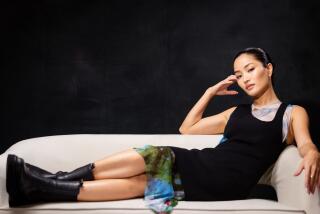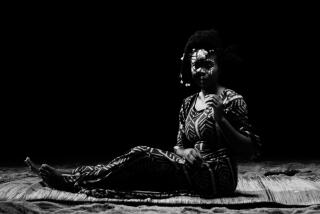Charlip Trying to Cast Light on Sun Goddess
Remy Charlip isn’t used to portraying anybody on stage but himself. However, in the small theater at the Museum of Contemporary Art, the veteran choreographer, dancer, artist and author is rehearsing the title role of Amaterasu--a mythic Japanese sun goddess--in a new quasi-operatic theater piece opening tonight at MOCA.
But, after sashaying down a steep ramp with the hauteur of a petulant Tallulah Bankhead, he interrupts his drag impersonation.
“I’m not completely happy with the way I’m doing this character,” Charlip explains. The problem, he says, is that while the characterization has many comedic properties, playing Amaterasu as a high-handed, superior individual can turn the audience against her.
“I worked my butt off to do this production . . . and still I panic,” Charlip says in words now included in the text of his piece. “Will I be good enough. . . ? Dare I show my violent side, my feminine side? Well, I will.”
“Amaterasu” features Carl Stone’s electro-acoustic music, Stephen Arnold’s punked-out scenic units in Imperial Japanese style and Stephen Bennett’s celestially evocative lighting. It is about an angry sun goddess who must be cajoled out of hiding in order to return light to the world. In the process, she transforms herself.
Charlip confesses that it’s also his transformation that concerns him and asserts that he and Amaterasu are “two sides of the same coin.”
“I call (this work) spotlight therapy,” he says, though the project (and approach) emerged largely through the influence of MOCA curator Julie Lazar, who invited Charlip to be the museum’s first artist-in-residence.
“When we first started working we wondered: ‘Should I do all the parts and will they think I’m egotistical,’ ” Charlip recalls. “But Julie (Lazar), Rachel (Rosenthal), Anatto (Ingle), Steven Arnold and James (Leo Herlihy) convinced me to do it this way.
Charlip has already anticipated the potential criticism lavished on such autobiographically based theatrical work: “That it’s overly self-reflexive and self-indulgent.”
He believes that work that doesn’t confront the self from which it arises is “not only dishonest, but ineffective” and adds that “burn-out, artistic or otherwise, occurs when you think you’re doing something for somebody else. Then the work is a drudgery. It doesn’t jell and has no spirit.”
A 58-year-old former Merce Cunningham dancer, with a background in Julian Beck’s Living Theater, children’s book writing and the visual arts, Charlip emerged in the ‘60s as a pioneer in New York’s revolutionary Judson Church dance scene where he strove to place an artist’s personal vision over movement virtuosity.
“You don’t create a dance because you want beautiful movement, you work with the dancers to get them to feel good about themselves and then they will do beautiful movement,” he says.
Charlip is a certified teacher of Alexander Technique, a discipline in body awareness that seeks to reduce extraneous stress when performing a given action. Moreover, during the last five years, he has co-taught at the Center For Intuitive Development in Utrecht, Amsterdam, and claims that his work as a healer has had a “tremendous influence” on his work.
“I don’t see the difference between (art) pieces and healing. At some point, you have a dance and it has a life of its own,” he says. “Or a play. Or a body. It’s all the same thing. It’s art. It’s healing. It’s education. It’s therapy. The idea is to abandon the judgment of others and be more yourself.”
More to Read
The biggest entertainment stories
Get our big stories about Hollywood, film, television, music, arts, culture and more right in your inbox as soon as they publish.
You may occasionally receive promotional content from the Los Angeles Times.










